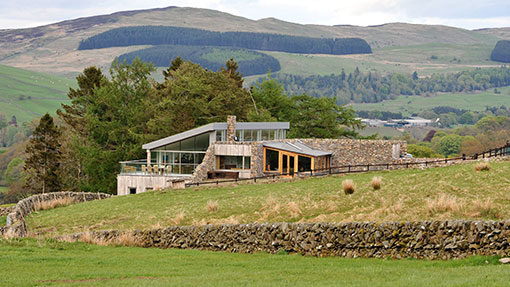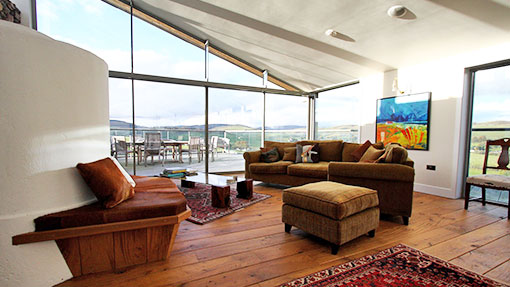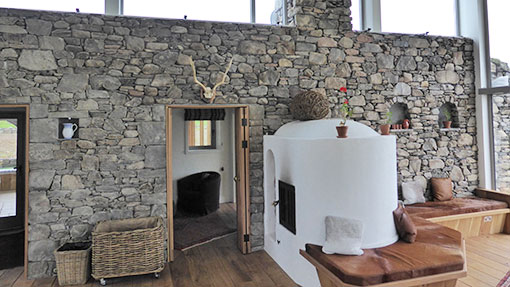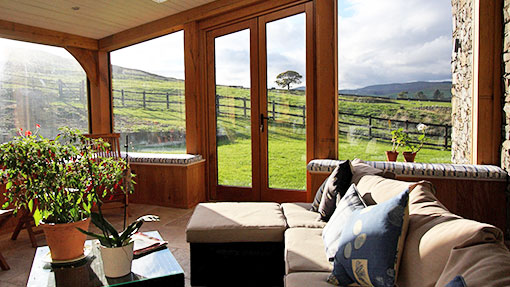Eco-friendly farmhouse sets agenda for rural economy

Cutting-edge architecture is helping keep a traditional way of life alive in south-west Scotland, as Will Frazer discovers.
Neil Gourlay blew the judges away with his simple and practical approach to incorporating renewable energy into a hill farming business in the Farmers Weekly Awards in 2011.
Since netting that win in the Green Energy Farmer of the Year category, he has taken his green energy ambitions to a whole new level by building a farmhouse that barely uses any energy.
The Grand Designs-style farmhouse is nestled into the side of the hill looking out over Moniaive, with stunning views across Dumfries and Galloway in south-west Scotland.
See also More on renewable farm energy
Architect Mark Waghorn certainly had his work cut out, with a brief to design it largely from materials found on the farm, so it blended seamlessly into the landscape.
With the business split three ways across beef, sheep and renewable energy, the intention was that the house would further diversify the business through catering for outdoor-pursuits tourists. It would ultimately be a place where Neil and his wife could retire, allowing their son to move into the original farmhouse and take on the business. Add this to the fact that it has always been a lifelong ambition, and you can see why he dedicated two years to completing the build.
“It has always been my dream to build a sustainable farmhouse out of all the raw materials that we have on the farm and have a house where you never have to pay a bill,” says Neil.

From across the valley, the property – The Three Glens – is almost invisible. It’s clad in oak boards gathered from fallen trees, with a steel frame to support the turf roof, cut from the ground on which the property now stands and pitched at the same angle as the valley slopes.
The wall insulation is produced from more than 2,000 fleeces of wool taken off the backs of his Blackface ewes, and inside the furniture is decked out with the hides of his own suckler cows. The tables, benches, chairs and flooring are made from oak railway sleepers, and the toilets, bath and sinks are all from a local reclamation yard. Even the toilet flushers have been replaced with sheep-horn handles. Despite all the reclaimed/recycled building materials, it has achieved a five-star guesthouse award and a gold eco-tourism grading.
The whole building is heated by a traditional Austrian “kachelofen”. This clay-clad, wood-fired oven sits right at the centre of the building, connected to three separate rooms and is incorporated into the stone dyke that runs the length of the house. The effect is a giant storage heater conducting heat throughout the house. A drive-in bunker at the back of the house stores the wood fuel gathered off the farm.
Alongside these traditional methods of building are the latest innovations in eco-technology. The whole building is pitched to optimise passive solar heating and all the windows are triple-glazed. An electronically controlled whole-house heat-recovery system and underfloor heating from a ground-source heat pump keeps the house at the optimum ambient temperature.

An electric cooker made by Everhot and motion-sensitive LED lighting are all powered from the 100kW wind turbine that sits on top of the hill at the back of the house and provides for its minimal power needs.
Deep in the glens of Scotland, a broadband internet connection was going to be a struggle. But with his Northern Power wind turbine came a broadband connection, installed to allow technicians from Massachusetts, USA, to control the turbine. The result is probably the fastest connection in the glens, making it an ideal choice for business customers.
Although these hills are a long way off the beaten track, Neil believes the area is a bit of a hidden gem and could become a more popular tourist destination given appropriate infrastructure.
“This area is so quiet there’s a real lack of cars but plenty of tarmac roads so it’s a brilliant part of the world for cycling. Walking is another popular pursuit, as is shooting and fishing.
“As a family, we thrive on in this landscape, so why shouldn’t others?” he says.
The house is now home to a professional couple who run it, looking after the guests and providing meals cooked from ingredients off the farm, showcasing the best-quality local and seasonal ingredients Scotland has to offer.
“The idea was to provide a ski-chalet-style experience, offering people not just a place to stay but also an opportunity to try the produce coming off our farm,” says Neil.
“I feel that my role is maintaining the rural economy and that involves employing local people to work the land.”
Traditionally that would have meant more shepherds and stockmen, but employing staff is often not an option for hill farm units due to the tight margins they have to operate on.
“Farming is hard to make a living out of on these hill units with suckler cows and sheep due to supermarkets squeezing prices,” he says.
With hill farming increasingly challenging, renewable energy (there are three micro-hydro schemes, as well as the 100kW wind turbine) has already provided a valuable lifeline for the productive farming landscape that Neil currently stocks with 3,000 Blackface ewes and 430 suckler cows.

“These kind of diversifications are a necessary alternative source of income for these sort of units,” he says. “In fact, my son Harry is now installing micro-hydro systems across the country as a business.”
“In 2012 we lost 370 ewes and 1,400 lambs in the late spring snow, and with the weather becoming so variable and margins slim, we have to find ways to keep the business propped up in times of trouble.
“Without that option, we’d be selling the stock and having to turn the land over to commercial forestry. I don’t want to see the countryside carpeted with Sitka spruce because once you turn land over to forestry you can’t go back, so this is our lifeline.
“What we’re doing here is adding to the viability of the business without losing any food production capacity.”
A thriving rural economy requires businesses that will bring people out of the cities and back on to the land, he says, and he employs more than eight staff across his different business units.
Ultimately, if Neil’s vision for The Three Glens as a catalyst for tourism in the area plays out, then the hill farm unit and the landscape will pass to his son in much better shape.
“All I can be judged on is what I take on and what I leave behind, hopefully in a better state for my son,” he says.
Neil Gourley’s top tips for building a house
- Choose a builder whose staff can perform all elements of the build and take responsibility for the whole project
- If using an architect, always research their portfolio to get a sense for their style and taste
- Be aware that civil engineering regulations are different in England than in Scotland
- Get someone local. British weather can play havoc with the best-laid plans, so if they’re local they’re more flexible about being on- and off-site
- Tie everything into one contract price
